Crowds and Credit February 4, 2011
Doug Wakefield
“…now that the recession
is over, we have to face the fact that the government must make cuts.”
“We put rules in place to
prevent another financial crisis…”
President Barack H. Obama,
State of the Union, Tuesday, January 24 ‘11
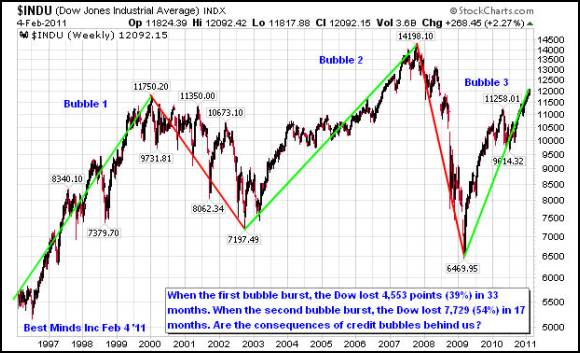
Manias
are fascinating to study in history, but are hard to accept if you are living
through one. The most memorable ones in history require two elements, crowds
and credit. While today’s global markets are littered with some of the most
complex financial instruments in history, anyone studying the history of
financial markets quickly recognizes that many of today’s tools for speculating
on future price movements can be found as far back as the Amsterdam Exchange,
founded in 1610. This exchange allowed speculators to take out margin loans,
invest in shares of the East India Company, and purchase futures contracts on
tulip bulbs. That’s right; tulip bulbs. 1
“By the later stages of the mania….paper credit created a perfect
symmetry of insubstantiality: most transactions were for tulip bulbs that could
never be delivered because they didn’t exist and were paid for with credit
notes that could never be honored because the money wasn’t there.” 2
Now
we move our time clocks forward almost 400 years. We examine a period that the
vast majority of investors personally experienced; the roaring ‘90s. As the Dow
roared up to it's top of 11,750, margin loans, stock shares, and futures
contracts were still apart of this mania, like the Tulip Bulb mania of the
early 1600s. Credit had exploded over the previous generation, with the belief
that cutting edge ideas would always find money available to make the visionary
rich. As the Dow topped out on January
14, 2000, the US national debt reached $5.7 trillion, a six-fold increase in
just twenty years. How many investors were thinking about the havoc that such a
rapid growth in debt could have on the pricing of not only their investments,
but their daily lives? Listening to the “New Era” stories and watching the
plethora of wealth being created almost overnight was much more emotionally
rewarding. Why should an explosion of debt be a factor for individuals and
institutions to consider when their money managers were boasting of their great
gains, the speed in which wealth increased was seen as a symbol of your
investment prowess, and the media was always there with another story of the
paradigm shift that would take us to an ever higher standard of living?
Today,
11 years later, I still find it amazing to read the works of those who
theorized tremendously higher prices ahead, and a plethora of options to attain
this newfound wealth.
“It is to avoid buying into bubbles that followers
of the Dow 36,000 Theory take the long view and count the cash. There are
hundreds of stocks (and hundreds of mutual funds, if they are your preference)
that offer high rewards at low risk.” 3
Dow 36,000: The New Strategy for Profiting From the
Coming Rise in the Stock Market (1999), James Glassman and Kevin Hassett
Now we come forward to February 4, 2011. The Dow’s
highest level was 12,092, just 342 points above the level hit on January 14,
2000. Millions want to believe the rhetoric that “the recession is behind us”,
and that the “recovery” is gaining steam. However, the crowd, having just lived
through the greatest loss of capital in history just 3 years ago, is awakening
to the alarming pace at which debt and government spending is accelerating.
In order to gain our bearings, with the plethora of
noise about the urgency of today’s hot market news, or the pleasant rhetoric
that says, “don’t worry, leave the investing to us and your dreams will remain
intact”, we need to look at the two prior market tops on the Dow, and gain
perspective on the debt foundation that continues to increase risk throughout
the entire global financial system.
As already mentioned, the Dow finally topped from
the credit/tech bubble on January 14, 2000 when the national debt stood at $5.7
trillion. After watching the Dow fall 4,553 points over 33 months, cheap credit
and the promotion of the next scheme lead the Dow up to 14,198 on October 11,
2007. At this stage, the credit/real estate bubble fueled by massive levels of
debt on top of debt schemes, had pushed the US national debt levels up to $9
trillion. The carnage that would follow would tear 7,729 points off the Dow in
just 17 months.
Now we come to February 4, 2011. Millions went home
today, having watched the Dow move ever upward like a smooth Caribbean cruise
since the Dow closed right below 10,000 on August 26 ‘2010, with yet another
positive emotional fix from repeatedly hearing “market makes new 2 year high”.
However, how many mainstream financial pundits, or major news sources were
warning their viewers that since the October 2007 high, just 39 months ago, the
US national debt has grown by $5 trillion, moving the debt level to $14
trillion?
Look at it another way. It took 81 months between
the completion of the credit/tech bubble and the credit/real estate bubble, and
during that time, the US national debt grew $3.3 trillion. Since its March 2009
bottom, just only 23 months ago, the Dow has climbed faster than it did going
into its historic January 2000 top, and the October 2007 top. If we start at the peak of the credit/real
estate bubble in October 2007, we have also witnessed a $5 trillion growth in
the US national debt in only 39 months; $3.3 trillion in 81 months followed by $5
trillion in 39 months. Let me state that again, …$3.3 trillion in 81 months
followed by $5 trillion in 39 months….Hello? How can any sane financial,
academic, military, spiritual, or political leader look at these numbers and
honestly convince those who are listening to them that “the recovery is
gathering steam”? Simple, because credit gives us the illusion of wealth and
power, until wealth and power are taken from us.
In the spring of 2009, shortly after the market
bottom, I received a call from an institutional manager with 40 years in the
business. His comment still haunts me today and has been a part of several
phone calls since. “Doug, it would
appear that we have learned nothing. We are now starting a Treasury bubble”. Just 5 months before the March 2009 bottom,
the world, and we had watched the Dow drop 3,770 points (32%) in six
weeks.
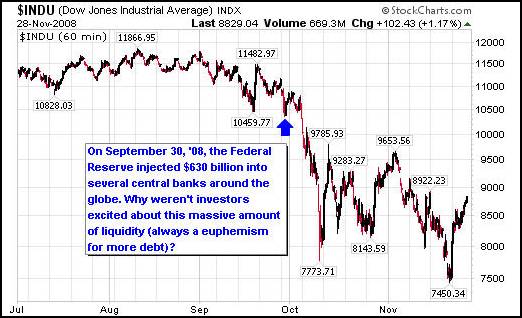
While a corrective wave would have been in order,
what we have watched since March 2009 is truly remarkable, and will certainly
be included in the Hall of Fame of manias when we look back on this period. In order to place the current Dow rally in
perspective, we must understand some major changes that have taken place at the
foundational level since the 2007 global credit bubble burst.
First, the sentiment among the average American
attitude has changed regarding savings, having lived through the tech and real
estate credit bubbles. Instead of buying everything on credit, the public’s
desire to pay down debt and build savings has changed. The St. Louis branch of
the Federal Reserve makes it clear that the appeal for increased savings
is a change from a trend toward decreased savings that had been in place
since 1981.
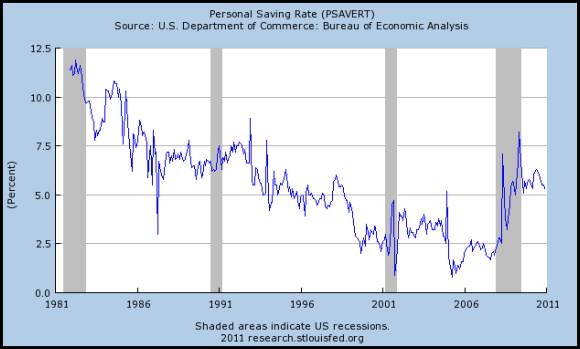
“….it s not lower interest rates per se that
improve the economy, rather it is the people’s reaction to lower interest rates
(that is, borrowing money to spend and saving less) that improves the economy.”
4
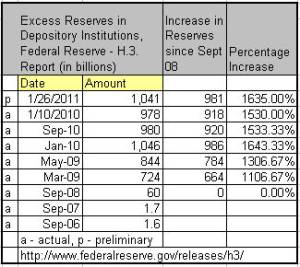 Richard
Koo, Chief Economist for Nomura Securities, author of Balance Sheet Recession:
Japan’s Struggle with Uncharted Economics and It's Global Implications (2003).
Richard
Koo, Chief Economist for Nomura Securities, author of Balance Sheet Recession:
Japan’s Struggle with Uncharted Economics and It's Global Implications (2003).
Second, the public was told that the nation’s
largest banks needed capital in order to restore the lending mechanism in the
system. Yet when one looks at the data on excess reserves, we see almost a
trillion still sitting in the banking system today, almost 2 years since the
March 2009 bottom in the Dow. Is there some reason that these banking giants
are still sitting on this level of reserves, even though the “recession is
behind us”?
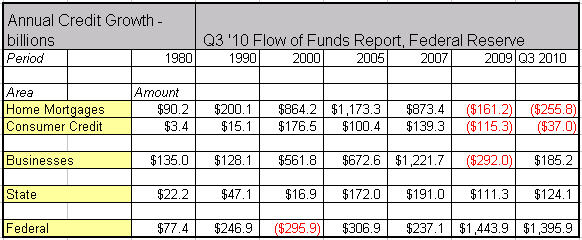
Third, we look at credit growth. Looking at the
chart above, it should lead each of us to ask some hard questions. The Federal
Reserve’s own data reveals that since 2007, home mortgage lending has collapsed
from growing at an annual pace of $1,173 billion to contracting at
a pace of $255 billion, and business lending has fallen from an annual pace of
$1,221 billion to only $185 billion. This massive contraction of credit in the
private sector has occurred during a period where individuals have watched the
Dow recover 72% of its 7,729-point loss. Clearly, there is a massive disconnect
between the economy and the stock market. If we then add the fact that the
federal government, whom our own president recently announced “must make cuts”,
has sought to pick up this massive contraction in credit by expanding it's own
credit growth almost six fold since the 2007, then we are not looking at a true
economic recovery, but a rising dependency on the state, and dependency on the
nations of the world to lend these massive sums to the US. One realizes how
extreme the current mania behavior has become when we compare Federal credit
growth in 2009 and Q3 2010 with the US government deficits of $1.3
trillion in 2010, an improvement from the $1.4
trillion deficit in 2009.
Sadly, Americans would rather believe the lie, and
trust that whoever, and however, their 401k and brokerage statements are
growing in value, is somehow “too complicated” to understand. The reality of
manias always boils down to crowds desiring something that history has already
told them is impossible to sustain.
I asked Bob Lang of Lang Asset Management, if he would make a
comment on crowds and credit, since he has been in investment management more
than 50 years.
“I can recall advice given to me 10 years ago that was prescient. It
was given in an environment where, in my naïve opinion, market optimism was
unsustainable.
It was in 1999, when technology was the unquestioned growth vehicle,
various ratios were so high that they were hard to accept as reality, and debt
accumulation by the government was becoming a concern. I was contemplating
changing our company’s long-term focus from being bullish to bearish since it
was becoming increasingly obvious to me that the prospect of our clients
continuing to profit from maintaining a long strategy in such an environment
appeared to be highly unlikely. This was a major change since I had been
optimistic about the country’s future (and the stock market) from the time I
had entered the business in 1959.
I decided to talk to several members of the investment community that
had already made the transition to the short side. One interview was
particularly troublesome to me since the veteran presented an outcome that I
just could not envision. His comments went like this: One of the most difficult
factors to accept in a period of excessive speculation, where you know reality
has taken its leave, is that the process can continue far longer than you think
remotely possible. In fact, you may begin to question whether your assessment
of the facts is accurate, while your newer clients have already made the
determination that you are inflexible, terribly misguided, and should proceed
immediately to participate in the never ending euphoria.” 5
Bob opened a long/short, and a short only strategy
in January 2000. For those starting at this juncture, he was seen as a savvy
manager 3 years later. For those that rode the next credit bubble up, he was
terribly misguided and inflexible. During the last 11 years, he has now seen
two of the worst market crashes in history, and yet is still perceived as misguided.
When your own market system allows enormous borrowing to occur daily by Wall
Street banks for “liquidity” through the Permanent Open Market
Operations (a program that just happened to start the same month the Dow
hit its major bottom in March 2009 and available only to a small group of
financial institutions), and the same banks continue to build their excess
reserves to the highest levels in US history, it makes one wonder how long before
this farcical period ends, and a true panic to sell sets in again.
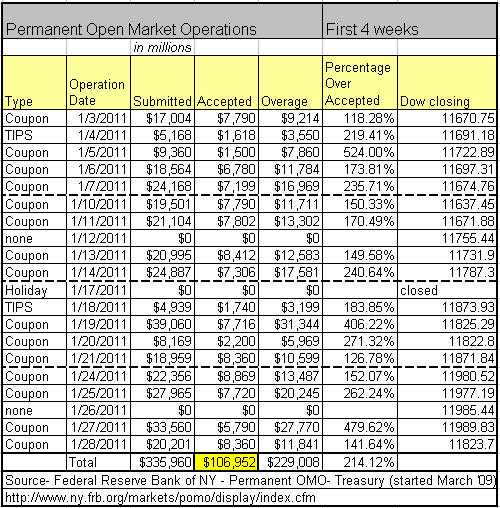
“A crash is a collapse of the prices of assets, or
perhaps the failure of an important firm or bank. A panic, “a sudden fright
without cause”, from the god Pan, may occur in asset markets or involve a rush
from less to more liquid assets. Financial crisis may involve one or both, and
in any order. The collapse of South Sea stock and the Sword Blade Bank almost
brought down the Bank of England. The 1929 crash and panic in the New York
stock market spread liquidation to other asset markets, such as commodities,
and seized up credit to strike a hard blow at output.” 6
Charles Kindleberger, Professor of Economics Emeritus at MIT, and author of Manias, Panics, and Crashes: A History of Financial Crises.
We are told there is plenty of
“liquidity” to help foster “stability” in our markets. Yet history has
always shown that while great ideals like the Declaration of Independence
embrace the concept that “all men are equal”, this has never applied to
financial markets. When one group of participants has the power to attain
hundreds of billions in new reserves by which to “start over”, while others
have no access to this enormous pool of credit, it becomes imperative to watch
for continued changes at the systemic level of our markets….
“Even
as financial markets collapsed last year[2008], high-frequency traders
collectively enjoyed $21 billion in gross profit, according to Tabb Group. On
the NYSE, daily volume surged 43% through June from a year earlier to 6.2
billion shares; high-frequency traders are believed to account for 50% to 70%
of the activity and similar proportions in electronic futures and options
markets… Some high frequency traders are sending out 1,000 orders a
second." 7
…and warning signs that the unsustainable rally is once again coming to
an end.
“Later, CEOs, who sold shortly before the peak [2000] would claim that
they just got lucky. ‘Who knew?’ one told The Wall Street Journal. But it
seemed that many knew. This was not what corporate PR departments dismissed as
‘part of a regular pattern of selling.’ This was a sudden bulge in insider
sales. By February of 2000- just weeks before the Nasdaq would peak – insiders
were selling 23 times as much stock as they bought, compared with the typical
ratio of 10 to 1. In July, they were not fooled by a summer rally; that money
the ratio remained at 22 to 1.” 8
Insiders have officially marked the top of the stock market: last
week's insider selling of all stocks (not just S&P) hit an all time record
of $4.5 billion. This is the biggest weekly number ever recorded by tracking
company InsiderScore.com: as Sentiment Trader highlights no other week before
had more than $2 billion in net selling. Furthermore, selling in just S&P
companies hit a whopping $2.8 billion: over 4 times more than the week prior!
As such the ratio of insider selling to buying is now meaningless. Even
Bloomberg, which traditionally just posts the data without providing commentary
to it, highlighted this ridiculous outlier:
"Insider selling at Standard & Poor’s 500
Index companies reached a record in the past week as executives took advantage
of a two-year high in the stock-market to sell their shares."
We hope those retail investors who dared to
reemerge in the stock market and play some hot potatoes with the big boys,
enjoy their brief profit as they once again end up being the biggest fools. 9
As
I continue to watch markets ignore world events like rioting in Egypt, Jordan,
Yemen, and Tunisia, or the deterioration in sovereign debts across major
European nations as bankers propose more debt to cover yesterday’s debt, or
shortfalls in the tens of billions in state revenues across the US, I
contemplate “the reason” that the public will be given for the start of the
next major decline in prices that far so long have been elevated from reality.
I dare say, I doubt we will hear that the public had grown complacent once
again from the memorizing effect of constantly rising market prices, supported
by beautiful lies from various leaders, solely to avoid living with the painful
reality that we were continuing to ignore the lessons on crowds and credits
from history.
So
when will this ever stop repeating itself we ask? Only when the “unlimited
debt” solution is no longer proposed as the solution, and the public refuses to
listen to any leader who hails it as the latest solution to our problems.
Sources:
1
– Devil Take the Hindmost: A History of Financial Speculation (1999) Edward
Chancellor, pg 10
2
– Ibid, pg 18
3
– Dow 36,000: The New Strategy for Profiting From the Coming Rise in the Stock
Market (1999), James Glassman and Kevin Hassett, pg 36
4 – Balance Sheet Recession: Japan’s Struggle with Uncharted Economics and
It’s Global Implications (2003), Richard Koo, pg 40
5
– Bob Lang is CEO and Chairman of Lang Asset Management. His comments were made
to the author on February 1, 2011. (www.langasset.com)
6
– Manias, Panics, and Crashes: A History of Financial Crises, Fourth Edition
(2000), Charles P. Kindleberger, pg 105
7
– The
New Masters of Wall Street, Forbes, September 21, 2009
8
– Bull: A History of the Boom, 1982-1999 (2003) Maggie Mahar, pgs 317-318
9
–Insider
Selling Hits All Time Record of $4.5 billion in Prior Week as Everyone is
Getting out of the Market, Zero
Hedge, November 11, 2010
Due to the levels we have
reached in this mania, and the manipulation we have watched unfold in the last
2 years, I have decided to place my entire research report, Riders on the
Storm: Short Selling in Contrary Winds (2006), on the web. The document can
be downloaded for free by clicking
this link, or scrolling down to Recent Updates on the Best Minds Inc homepage. 2011 is
setting up to require a totally different view of strategies than the last 2
years, and during this time of enormous deception will require examining a wide
range of markets through a variety of lenses.
If you are interested in our
most comprehensive research, consider a subscription to
The Investor's Mind:
Anticipating Trends through the Lens of History.
Doug Wakefield
President
HUBest Minds Inc.UH, a Registered Investment Advisor
2548 Lillian Miller
Parkway
Suite 110
Denton, Texas 76210
Phone - (940) 591 - 3000
Alt - (800) 488 - 2084
Fax - (940) 591 –3006
Best Minds, Inc is a registered investment
advisor that looks to the best minds in the world of finance and economics to
seek a direction for our clients. To be a true advocate to our clients, we have
found it necessary to go well beyond the norms in financial planning today. We
are avid readers. In our study of the markets, we research general history,
financial and economic history, fundamental and technical analysis, and mass
and individual psychology.
Disclaimer:
Nothing in this communiqué should be construed as advice to buy, sell, hold, or
sell short. The safest action is to constantly increase one's knowledge of the
money game. To accept the conventional wisdom about the world of money, without
a thorough examination of how that "wisdom" has stood over time, is
to take unnecessary risk. Best Minds, Inc. seeks advice from a wide variety of
individuals, and at any time may or may not agree with those individual's
advice. Challenging one's thinking is the only way to come to firm conclusions.